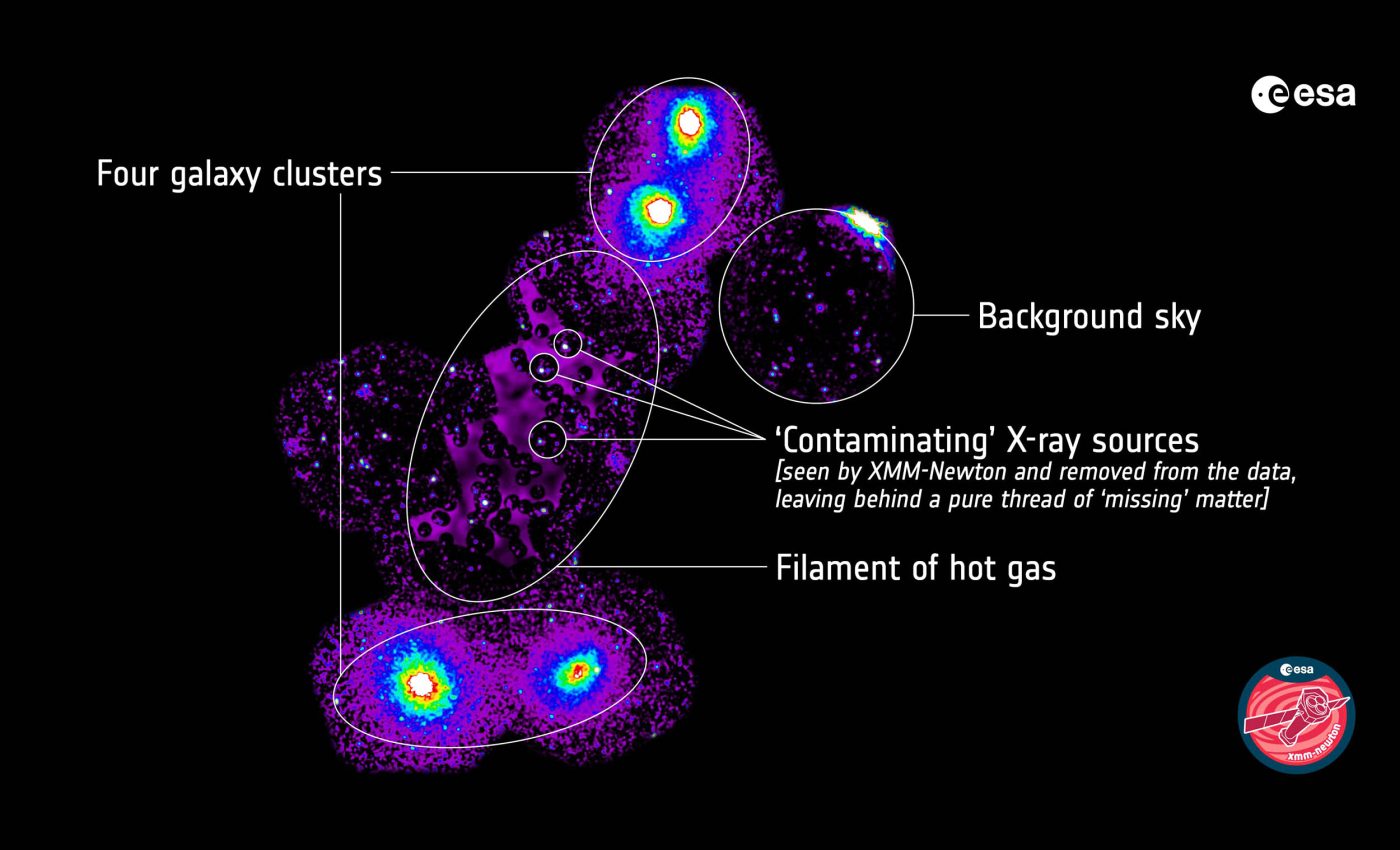
Scientists found some of the "missing matter" in the universe after searching for decades
Cosmologists have known for decades that only a sliver of the universe is made of the same stuff as people, planets, and pets. Analyses of the cosmic microwave background by the Planck satellite pinned ordinary matter to just under five percent of everything that exists.
Surveys of nearby galaxies, however, kept coming up one‑third short, a quandary dubbed the missing‑baryon problem.
The latest effort to plug the gap comes from lead researcher Konstantinos Migkas of Leiden Observatory, whose team has spotted part of the unseen stockpile running through the Shapley Supercluster.
Where the ordinary matter hides
Large‑scale simulations predict that most of the uncounted atoms sit in vast strands of gently glowing gas that lace together clusters of galaxies.
This reticulated structure, known as the warm‑hot intergalactic medium or WHIM, should reach temperatures of one to ten million degrees yet remain so tenuous that it barely glimmers against the X‑ray sky.
Observations using fast radio bursts recently confirmed that missing ions float between galaxies, but they could not show where the plasma lives. Astronomers therefore still needed a map that links the mass to the cosmic web sketched by theory.
Finding a hidden cosmic filament
Migkas and colleagues aimed their study at the Shapley Supercluster, a behemoth containing more than 8,000 galaxies about 650 million light‑years away.
They focused on a diagonal bridge that links four of Shapley’s galaxy clusters along a span of 23 million light‑years.

“For the first time, our results closely match what we see in our leading model of the cosmos, something that’s not happened before,” exclaimed Migkas.
Two ends of the bridge lie at cluster pair A3532–A3530, the other at A3528‑N/S, while the middle floats in inter‑cluster space.
Cosmic filaments and X-rays
To separate the slender glow from brighter background clutter, the team combined the broad Suzaku X‑ray view with the sharper eyesight of XMM‑Newton.
Suzaku measured the diffuse haze, and XMM‑Newton peeled away pointlike sources so that black holes and star‑forming galaxies could not masquerade as filament light.
“Thanks to XMM‑Newton we could identify and remove these cosmic contaminants, so we knew we were looking at the gas in the filament and nothing else,” added Florian Pacaud, University of Bonn.
After cleaning, the filament still shone about twenty percent brighter than the cosmic X‑ray background across a width of nearly 750,000 light‑years.
Why this matters (no pun intended)
Spectra reveal that the bridge gas sits near 0.9 keV, roughly 10 million degrees, squarely in the WHIM regime but cooler than the clusters it links.
Number‑crunching shows an electron density close to ten millionths per cubic centimeter, giving a baryon overdensity around 36, almost exactly the value simulations forecast for short filaments.
Those figures align with estimates from IllustrisTNG, which predicts that the densest filaments hover at thirty to forty times the mean cosmic density while staying too hot for ultraviolet telescopes.
Earlier X‑ray campaigns hinted at WHIM but often found higher densities, likely because unresolved black holes muddied the data; the new study’s meticulous source removal tackles that pitfall.
How this cosmic filament stacks up
Unlike superclusters or galaxy walls that stretch across hundreds of millions of light‑years, this filament spans a modest 23 million light‑years.
Still, with a gas mass of roughly twelve trillion suns, it carries more than enough baryons to rival much larger structures in its local region.

Other studies using eROSITA data detected filaments with five times the density, but those results likely included contamination from nearby halos and unresolved sources.
The new filament stands out not just for its size but for how closely its properties match the clean predictions from large-scale simulations.
Where we go from here
By weighing the filament, researchers calculate a gas mass of about twelve trillion suns, comparable to the combined hot atmospheres of the four clusters it connects.
That haul chips away at the missing‑baryon ledger and underscores that intergalactic strands cannot be ignored when balancing the cosmic budget.
Future X‑ray missions will widen the search, yet optical and radio surveys also help.
Fast‑radio‑burst researchers show that roughly half of normal matter floats outside galaxies and the European Space Agency’s Euclid spacecraft is building a three‑dimensional map of the cosmic web to trace where that plasma gathers.
Spotting more pristine filaments will clarify how gas flows into clusters and feeds star formation over time. It may also extinguish the last doubts about whether today’s stocktake of ordinary matter really matches the five‑percent prediction.
The study is published in Astronomy & Astrophysics.
—–
Like what you read? Subscribe to our newsletter for engaging articles, exclusive content, and the latest updates.
Check us out on EarthSnap, a free app brought to you by Eric Ralls and Earth.com.
—–













